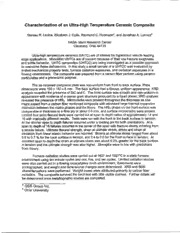
Characterization of a Ultra-High Temperature Ceramic Composite PDF
Preview Characterization of a Ultra-High Temperature Ceramic Composite
Characterization of an Ultra-High Temperature Ceramic Composite Stanley R. Levine, Elizabeth J. Opila, Raymond C. Robinsona, and Jonathan A. Lorinczb NASA Glenn Research Center Cleveland, Ohio 441 35 Ultra-high temperature ceramics (UHTC) are of interest for hypersonic vehicle leading edge applications. Monolithic UHTCs are of concern because of their low fracture toughness and brittle behavior. UHTC composites (UHTCC) are being investigated as a possible approach to overcome these deficiencies. In this study a small sample of a UHTCC was evaluated by limited mechanical property tests, furnace oxidation exposures, and oxidation exposures in a flowing environment. The composite was prepared from a carbon fiber perform using ceramic particulates and a preceramic polymer. The as-received composite plate was non-uniform from front to back surface. Plate dimensions were 150 x 150 x 6 mm. The back surface had a fibrous, uniform appearance; XRD analysis revealed the presence of Sic and C. The front surface was smooth and non-uniform in appearance with evidence of a coarse grain structure produced by a liquid phase; XRD analysis revealed the presence of HfB2. Microcracks were present throughout the thickness as one might expect from a carbon fiber reinforced composite with attendant large thermal expansion mismatch between the matrix phases and the fibers. The HfB2 phase on the front surface was comparable in thickness to a fiber ply or about 0.6 mm, and surface microcracks were evident. Limited four point flexural tests were carried out at span to depth ratios of approximately 14 and 16 with markedly different results. Tests were run with the front or the back surface in tension. At the shorter span to depth failures occurred under a loading pin for both orientations. At a span to depth of 16 failures occurred in the center of the span with fracture clearly initiating from a tensiie faiiure. Ultimate flexural strength, strain at ultimate stress, stress and strain at deviation from linear elastic behavior are reported. Strains at ultimate stress ranged from about 0.6 to 0.7 % for the back surface in tension, and 0.4 to 0.6 for the front surface in tension. At constant span to depth the strain at ultimate stress was about 0.2% greater for the back surface in tension and the ultimate strength was also higher. Strengths were in line with predictions from theory. Furnace oxidation studies were carried out at 1627 and 1927OC in a static furnace environment using ten minute cycles and one, five, and ten cycles. Limited oxidation studies were also carried out in a flowing oxyacetylene torch environment. Specimens were photographed, and weight and dimensional changes were determined. XRD and SEM characterizations were performed. Weight losses were attributed primarily to carbon fiber oxidation. The composite survived the torch test with little visible distress. Further details will be determined once metallographic studies are completed. a QSS Group Inc. Ohio University a, t 3 I cu t a, r) E a, c .-I =- m- I cu - N a, 0 m t m 0 0 0 0 0 a, . . c 0 S 0 m m- m .- a, v) .N 0 v) m- E a, 0 I L m- a 0 a, L m I a, m ? n.- X a, n i- U 0 o . C 0 .I U m CI 0 Q 2. I Q) m 0 b C 0 0 U 0 S .I U t) C t) Q) 3 I- I 3 I I o
